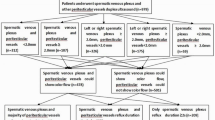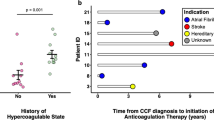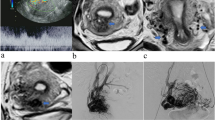Abstract
While dynamic infusion cavernosometry (DIC) is being performed with increasing rarity, some centers continue to use this investigation modality. Cavernosography may be utilized to identify the location of patent venous channels in men with venous leak. In an era when venous ligation surgery is being performed with less frequency, the role of cavernosography has been questioned. This study was conducted to define the congruence between the three parameters (flow-to-maintain (FTM), pressure decay (PD) and cavernosography) used in the diagnosis of venous leak during DIC. Established values for the three parameters were utilized and the diagnosis of venous leak was based upon the FTM measurement. All studies were performed using a vasoactive agent-redosing schedule. Cavernosography was conducted using a nonionic contrast agent at an intracorporal pressure of 90 mmHg. In patients with an elevated FTM value, 24% had a normal PD recorded, all of whom had FTM values <10 ml/min. The Pearson correlation coefficient for the relationship between FTM and PD was 0.58 (P=0.025). In all, 36 patients (54%) had an abnormal cavernosogram (CG). All patients who had positive findings on CG had elevated FTM values. On the other hand, 46% of patients with abnormal FTM values had a normal CG. This analysis indicates that almost one-half of men with venous leak diagnosed at the time of DIC based on FTM measurement will fail to have any veins visualized on cavernosography. These data further undermine the value of cavernosography, particularly in men with low-grade venous leak.
This is a preview of subscription content, access via your institution
Access options
Subscribe to this journal
Receive 8 print issues and online access
$259.00 per year
only $32.38 per issue
Buy this article
- Purchase on Springer Link
- Instant access to full article PDF
Prices may be subject to local taxes which are calculated during checkout



Similar content being viewed by others
References
Broderick GA, Arger P . Duplex Doppler ultrasonography: noninvasive assessment of penile anatomy function. Semin Roentgenol 1993; 28: 43.
Quam JP et al. Duplex color Doppler sonographic evaluation of vasculogenic impotence. Am J Roentgenol 1989; 153: 1141.
Karadeniz T et al. Judgment of color Doppler ultrasound with respect to cavernous artery occlusion pressure in dynamic infusion cavernosometry when evaluating arteriogenic impotence. Urol Int 1996; 57: 85.
Karadeniz T et al. Value of color Doppler sonography in the diagnosis of venous impotence. Urol Int 1995; 55: 1.
Motiwala HG . Dynamic pharmacocavernosometry: a search for an ideal approach. Urol Int 1993; 51: 1.
Velkova K, Shopov A, Dichev B . Radiologic methods used in the diagnostics of vasculogenic erectile dysfunction. Folia Med 1992; 34: 33.
Kayigil O, Atahan O, Metin A . Dynamic infusion cavernosometry cavernosography in diagnosing classifying venoocclusive dysfunctionInt. Urol Nephrol 1995; 27: 615.
Mulhall JP, Abdel-Moneim A, Abobakr R, Goldstein I . Improving the accuracy of vascular testing of the impotent male: correction of hemodynamic alterations using a vasoactive medication redosing schedule. J Urol 2001; 166: 9232.
Fehr JL et al. Significance of cavernosography in standardized cavernosometry. Urol Int 1992; 49: 13.
Chen KK et al. Dynamic infusion cavernosometry cavernosography (DICC) in the evaluation of vasculogenic impotence. Chung Hua I Hsueh Tsa Chih (Taipei) 1996; 57: 266.
Lue TF . Penile venous surgery. Urol Clin North Am 1989; 16: 607.
Puech-Leao P . Venous surgery in erectile dysfunction. Urol Int 1992; 49: 29.
Lue TF . Surgery for crural venous leakage. Urology 1999; 54: 739.
Rogers RS, Lue TF . Penile venous surgery benefits patients under years of age. J Urol 1999; 161: 258.
Berardinucci D et al. Surgical treatment of penile veno-occlusive dysfunction: is it justified? Urology 47; 88: 1996.
Goldstein I, Krane RJ, Greenfield AJ, Padma-Nathan H . Vascular diseases of the penis: impotence priapism. In: Pollack HM (ed). Clinical Urography. WB Saunders: Philadelphia, 1990.
de Meyer JM, Thibo P . The effect of re-dosing of vasodilators on the intracavernosal pressure on the penile rigidity. Eur Urol 1998; 33: 293.
Pescatori ES et al. Audiovisual sexual stimulation by virtual glasses is effective in inducing complete cavernosal smooth muscle relaxation: a pharmacocavernosometric study. Int J Impot Res 2000; 12: 83.
Mulhall JP, Damaser MS . Development of a mathematical model for the prediction of the area of venous leakage. IJIR 2001; 13: 236.
Hatzichristou DG et al. In vivo assessment of trabecular smooth muscle tone its application in pharmaco-cavernosometry analysis of intracavernous pressure determinants. J Urol 1995; 153: 1126.
Author information
Authors and Affiliations
Corresponding author
Rights and permissions
About this article
Cite this article
Mulhall, J., Anderson, M. & Parker, M. Congruence between veno-occlusive parameters during dynamic infusion cavernosometry: assessing the need for cavernosography. Int J Impot Res 16, 146–149 (2004). https://doi.org/10.1038/sj.ijir.3901177
Received:
Revised:
Accepted:
Published:
Issue Date:
DOI: https://doi.org/10.1038/sj.ijir.3901177



